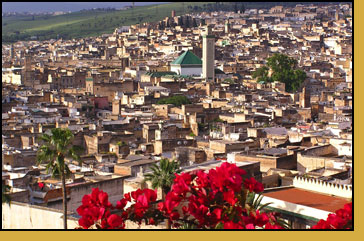



Morocco & Andalusia: Fes
 Fes, without question Africa’s most fascinating city, owes its architectural splendors and its status as a “holy city of Islam” somewhat ironically to a Berber dynasty, the 14th-C. Merinids. While founded in the early 800s CE by the Idrissids, Arab descendants of the Prophet, the founders were nearly forgotten with passing centuries and the city played second fiddle to the capital of the then great Moroccan empire, Marrakech. By the time the Merinids took power, the empire had dwindled, the “Moors” were being forced out of Spain, and the new dynasty was desperate for an affirmation of its status. What a better symbol than to rule from the city founded by a direct descendant of Prophet Muhammad! The Merinids set up Fes as their capital and dotted the city with schools, shrines, caravansaries, and palaces with decor to rival the Alhambra (which, incidentally, was built by Berber craftsmen). Keeping with the wishes of the city’s founder, Fes remained open to refugees of any religion and creed fleeing persecution. The Merinids also glorified the city by molding its history to what they wanted the world to believe, doing such a good job that to this day scholars cannot fathom what is truth or legend of pre-Merinid Fes.
Fes, without question Africa’s most fascinating city, owes its architectural splendors and its status as a “holy city of Islam” somewhat ironically to a Berber dynasty, the 14th-C. Merinids. While founded in the early 800s CE by the Idrissids, Arab descendants of the Prophet, the founders were nearly forgotten with passing centuries and the city played second fiddle to the capital of the then great Moroccan empire, Marrakech. By the time the Merinids took power, the empire had dwindled, the “Moors” were being forced out of Spain, and the new dynasty was desperate for an affirmation of its status. What a better symbol than to rule from the city founded by a direct descendant of Prophet Muhammad! The Merinids set up Fes as their capital and dotted the city with schools, shrines, caravansaries, and palaces with decor to rival the Alhambra (which, incidentally, was built by Berber craftsmen). Keeping with the wishes of the city’s founder, Fes remained open to refugees of any religion and creed fleeing persecution. The Merinids also glorified the city by molding its history to what they wanted the world to believe, doing such a good job that to this day scholars cannot fathom what is truth or legend of pre-Merinid Fes.
What to do
Being built on hill slopes, with its narrow alleyways snaking up and down, protected old Fes from any modern construction, as trucks and heavy machinery simply could not get in. Thus, just to walk through this maze, considered by scholars to be the truest example left of a typical medieval Arab city and a UNESCO World Heritage Site, is reason enough to visit Fes. At the city’s core lies the 9th-C. Al Qarawïne, the world’s oldest functioning university; only the library may be entered, though gates of the vast complex offer vistas on its rich interiors. The Merinid-era Koranic schools of Attarine and Bou Inania are unparalleled jewels of Morocco’s own interior decorative architecture, as is the shrine to the city’s patron “saint” Moulay Idriss II. The meticulously restored 14th-C. Nejjarine caravansary, an example to the world on how restoration should be done, now houses an exquisite collection of everything and anything that has to do with the use of wood in Morocco — sources, tools, weaponry, decor, etc. Beyond the monuments the alleys teem with life, along their fountains, public bakeries and bazaars still well delineated into specialty areas, where you can see masters toiling away with apprentices, just as they have for centuries. Add the famed, colorful leather tanneries, the city’s most photographed site.
There is also the 14th-C. “New” Fes, which the Merinids built as their lair above the old city. In it lies the Mellah, the Jewish quarter (it was under the Merinids that Mellahs were set up next to the palaces, for the eventual protection of the Jewish population), with the Judaic cemetery and the restored 17th-C. Aben Danan synagogue, a World Legacy Site, believed to be the last to contain a full set of Moroccan synagogue fittings. New Fes also has a museum of pottery, one of the city’s specialties, set in the late 19th-C. sultan’s palace of Dar Batha, with its serene garden; the Royal Palace, on the grounds of the Merinids’ original palace (cannot be visited... yet); and the Boujeloud “Blue” Gate, to some the prettiest of Morocco’s magnificent city gates. Overlooking it all is a museum of weaponry at the Borj Nord fortress, while just beyond the city lie the workshops for pottery and zellige tile mosaic, another Fesi specialty.
A Moroccan gazetteer: Tangier | Rabat & Casablanca | Andalusia | Meknes & Volubilis | Fes | Marrakech | The High Atlas | The Middle Atlas | Taroudant & the Anti Atlas | On the Sahara's Edge | The Atlantic Coast | Jewish Heritage | Architecture | Festivals
Plan your trip: Sample Itineraries | Hotels | Trip Request Form | Morocco ABCs